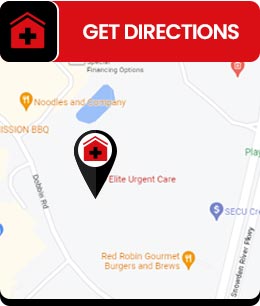Non-emergency Illness Treatment Clinic in Columbia, MD
Urgent care facilities are an excellent option for patients who require prompt medical care in non-emergency situations. Minor disorders/illnesses encompass any medical problem that is not life-threatening but necessitates medical attention. Non-emergency injuries include sprained knees, ankles, and arms, a slight headache, a pulled muscle, a managed nosebleed, and minor wounds. Non-emergency illness treatment is available at Elite Urgent Care. For more information, contact us today or book an appointment online. We are conveniently located at 6100 Dobbin Rd, Suite A Columbia, MD 21045.


Table of Contents:
What is a non-emergency illness?
What are five signs that a person has a non-emergency condition?
What are signs I should go to urgent care?
In most cases, you’ll know when a medical situation is a true emergency. Be sure to trust your judgment when it comes to identifying someone who needs immediate assistance. Any situation that requires immediate attention to prevent serious permanent harm to the patient qualifies for an ambulance call.
Heart attacks, strokes, severed limbs, poisoning, uncontrollable bleeding, internal bleeding, severe burns, electrical shocks, seizures, sudden severe headaches, severe allergic reactions, diabetic reactions, choking, suspected overdose, or suicidal thoughts can be examples.
An ambulance might be the best option for a patient if they are unconscious, having difficulty breathing, or suffering from extreme pain. In most cases, an ambulance can get someone to the hospital faster. In addition, the emergency team can provide help on-site before getting to the hospital.
You can categorize your concern as a non-emergency if it is not immediately life-threatening. In such cases, you should not use an emergency system, as it can create additional backlogs that can exclude people with more serious concerns. Don’t hesitate to take action if something seems life-threatening. Please contact a telehealth hotline with any questions you might have. As an alternative to emergency services, urgent care centers can be a good option.
If your medical issue does not threaten your life or a part of your body, you should visit urgent care. You’re likely to benefit from urgent care if, for instance, you’ve suffered a serious cut, but it’s not spurting blood, there isn’t any bone visible, or anything else that’s alarming. To minimize the risk of infection and scarring, lacerations should be cleaned and possibly stitched within hours hence the need for prompt, but not necessarily emergency, care.
The majority of colds and flu can be treated at home. However, if you are not sure whether you have a minor respiratory infection or something more serious, such as pneumonia, urgent care can be helpful.
There are a variety of fractures that can be treated in urgent care, including elbows, wrists, hands, fingers, ankles, feet, toes, and ribs. The emergency department is the best place to get treatment for anything more serious or complex, such as long bone fractures, and hip and back problems.
You may want to consider urgent care if you have chest pain under 55 (the age when heart disease risk increases for women), have no history of heart disease, and think you can pinpoint a minor cause.
If you are experiencing a medical issue you would otherwise wait to visit your primary care doctor to address it. Still, it is more pressing and they are unavailable urgent care is an excellent option. The idea that you can just go to urgent care if something comes up should not stop you from getting routine screenings and checkups. You should use it in conjunction with your regular preventive care when necessary, not as a replacement for it.
It is most likely that the patient does not need emergency services if they can function until they arrive at an urgent care center. An example would be an open wound that needs stitches but can be controlled with pressure, a minor allergic reaction, a possible broken bone, a high fever, or uncontrollable diarrhea.
You may be sent or taken to the emergency room in urgent care centers if necessary. Additionally, if the urgent care center is closed, the patient will probably need to be taken to the emergency room.
Non-emergency illness treatment is available at Elite Urgent Care. For more information, contact us or request an appointment online. We are conveniently located at 6100 Dobbin Rd, Suite A Columbia, MD 21045. We serve patients from Columbia MD, Ellicott City MD, Laurel MD, Elkridge MD, Clarksville MD, Fulton MD, Jessup MD, and surrounding areas.
Check Out Our 5 Star Reviews









